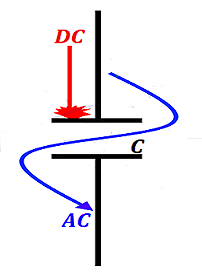Notes to a video lecture on http://www.unizor.com
Alternating Current and Capacitors
Let's start with a clear illustration of what we will discuss in this lecture.

The main idea is that alternating current (AC) goes through a capacitor, while direct current (DC) does not.
To explain this fact, consider how electricity is produced in both cases DC and AC.
For DC case we will use a battery that uses some chemical reaction to
separate some outer layer ("free") electrons from their atoms and moves
them toward a battery's negative pole, where excess of electrons will be
present, leaving deficiency of electrons on the positive pole.
If we connect the poles of this battery to two plates of a capacitor,
the excess of electrons from the negative pole of a battery will travel
to one plate, while the deficiency of electrons will be on the other
plates. It will continue until we reach a saturation of electrons on one
plate and their absence on another. The electromotive power of the
battery could not push electrons anymore to one plate, because their
repulsive force will be too strong. And that's it. Electrons will not
jump from one plate of a capacitor to another (unless the EMF of a
battery is so strong that it breaks the isolation between the plates of a
capacitor, which defeats the purpose), the circuit is not closed, the
current will not go through.
In AC case the generated electromotive force (EMF) is variable in magnitude and direction.
It starts with separating "free" electrons from their atoms, gradually
increasing the concentration of electrons on one pole and on the
capacitor's plate connected to it.
At the same time deficiency of electrons is observed on the other pole and a capacitor's plate connected to it.
That lasts for some short period of time (half a period), when the
generated EMF gets weaker and goes down to zero. This causes the excess
electrons from one capacitor plate to go back to a generator and
compensate the deficiency of electrons on the other plate. This ends
half a period of EMF oscillation.
On the next half a period the EMF changes the sign, electrons will be
accumulated on the plate, where previously we observed their deficiency.
On the plate where we had excess of electrons during the previous half a
period we will have their deficiency.
So, during the full cycle of two half-periods electrons move to one
plate of a capacitor, then back to a generator and to another plate of a
capacitor. Then the cycle repeats itself, electrons move within a
circuit with a capacitor back and forth, thus facilitating the
alternating current in this circuit.
Let's compare the alternating current in a case of a closed circuit without a capacitor with a circuit that has a capacitor.
We start in both cases with a device that generates alternating sinusoidal EMF
U(t) = Umax·sin(ωt)
where
U(t) is the generated EMF as a function of time t,
Umax is the peak value of EMF,
ω is the angular speed of rotation of a device generating the alternating EMF.
In a closed circuit with an alternating EMF and no capacitors, according to the Ohm's Law, the electric current I(t), as a function of time t, will be proportional to an EMF and will alternate synchronously with it
I(t) = Imax·sin(ωt)
where
Imax is the peak value of electric current in a circuit.
In case of a capacitor being a part of a circuit the situation is more complex.
As we know, the amount of electricity Q(t) accumulated in the capacitor is proportional to voltage U(t) applied to its plates, and capacity of a capacitor C
(see lecture "Electric Fields" - "Capacitors" in this course) is the
constant proportionality factor that depends on a type of a capacitor
C = Q(t)/U(t)
Therefore,
Q(t) = C·U(t) = C·Umax·sin(ωt)
Knowing the amount of electricity Q(t) accumulated in a capacitor as a function of time t, we can determine the electric current I(t) in a circuit, which is a rate of change (that is, derivative by time) of the amount of electricity
I(t) = dQ(t)/dt =
= C·Umax·ω·cos(ωt) =
= Imax·cos(ωt) =
= Imax·sin(ωt+π/2)
where
Imax = C·Umax·ω
Incidentally, expression which is called reactance, plays for a capacitor similar role to that of a resistance because, using this reactance, the formula for a peak value of the electric current in a circuit with a capacitor resembles the Ohm's Law
Imax = Umax/XC
What's most important in the formula I(t)=Imax·sin(ωt+π/2)
and the most important property of a capacitor in an AC circuit is
that, while an EMF in a circuit oscillates with angular speed ω, the electric current oscillates with the same angular speed ω as EMF, but its period is shifted in time by π/2 relative to EMF.
This is a very important capacitor's property used in AC motors, which will be a subject of the next lecture.


No comments:
Post a Comment